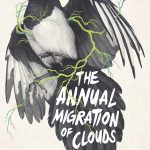The Annual Migration of Clouds imagines the University of Alberta as the site of a self-sustaining community in a dystopic near-future: the labyrinthine BioSci building is now living quarters and people risk their lives to hunt wild pigs in the river valley. The result, the fifth book from Edmonton’s Premee Mohamed, is a promising start to a series that brings big questions about humanity’s future close to home.
Our protagonist, 19-year-old Reid, carries a heritable fungal infection. It invades her mind, illustrated through a series of bracketed interruptions in the text, and she knows it will eventually kill her—just as it horrifically killed her grandmother. In the early pages, however, Reid is offered an out: an acceptance letter from a prestigious institution which cloistered itself in the before-times, free from disease and sheltered from the ravages of climate change. This triggers the question that haunts Reid for the entirety of the text: Will she leave the familiar grind of life on campus and abandon the only community she knows?
The novella’s strongest element is its subtle dismantling of techno-optimism in the face of human-made destruction. The university, once a temple to science, has been reduced to its mere infrastructure; medicine is no longer a vestige of hope when the doctors in Reid’s community are bloodthirsty and malicious. After all, Reid is living in the third generation of an endemic infection that society has failed to escape through research, law or space colonization. Perhaps, then, Reid is not merely choosing between her current community and a new one but between ideologies of mutual aid and futuristic innovation. The final chapters also open the question of whether the mental invasiveness of Reid’s fungal infection has protected her from danger, suggesting an innate and unknowable intelligence resistant to human intervention.
Reid does not make her final decision to stay or leave her home until the final pages, which leaves the novella feeling physically and narratively confined to its single setting on campus. Rather than seeing the consequences of her choices unravel in a more dynamic plot, Reid mulls over these fascinating thematic questions during the fairly mundane daily events of her life on the commune. The lingering effect is a book that reads more like a long, deliberative introduction to a larger story rather than a complete narrative in itself.
The effect seems to be intentional: ECW Press has recently announced that two sequels to The Annual Migration of Clouds are already in the works—all the more room to explore Reid’s journey and the delicate interplay between science, how we relate to each other, and the ecologies within which we live.
Kate Black is a writer from St. Albert now living in Vancouver.


